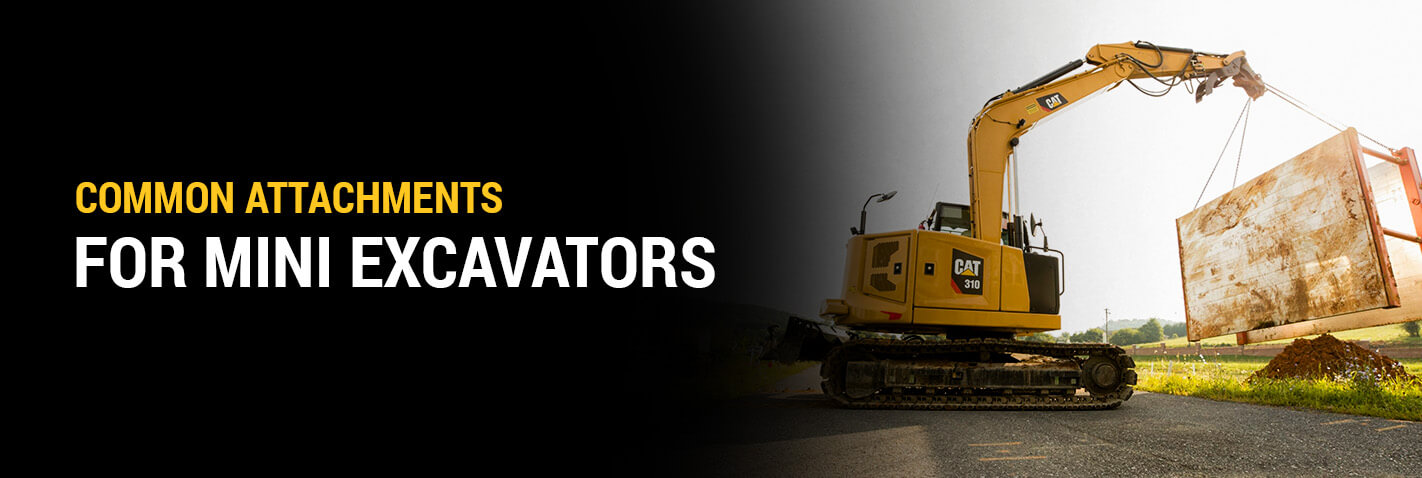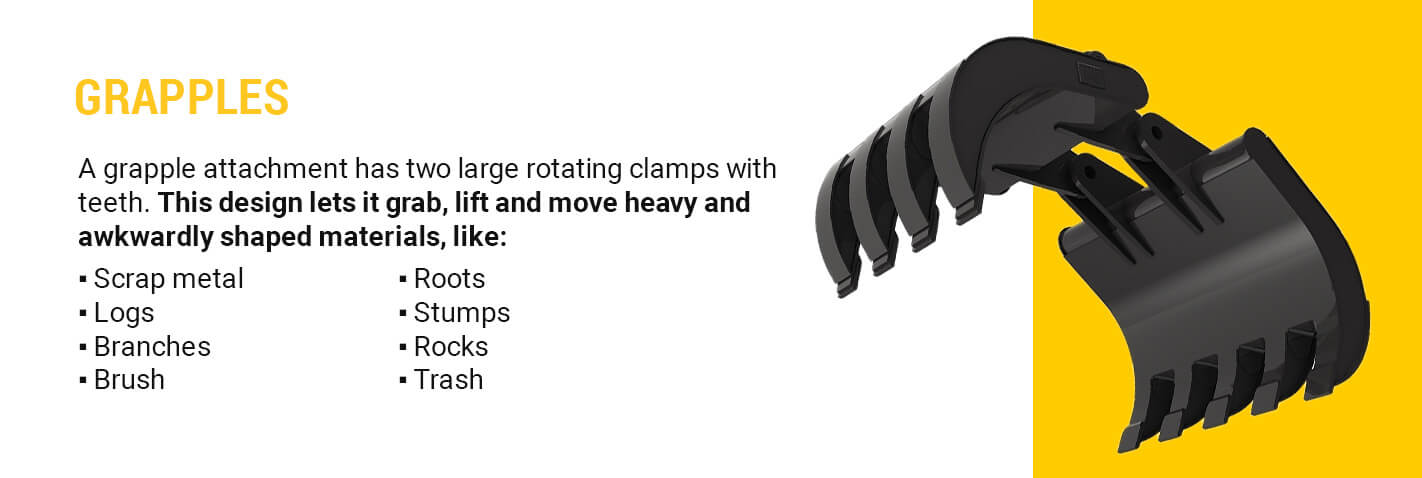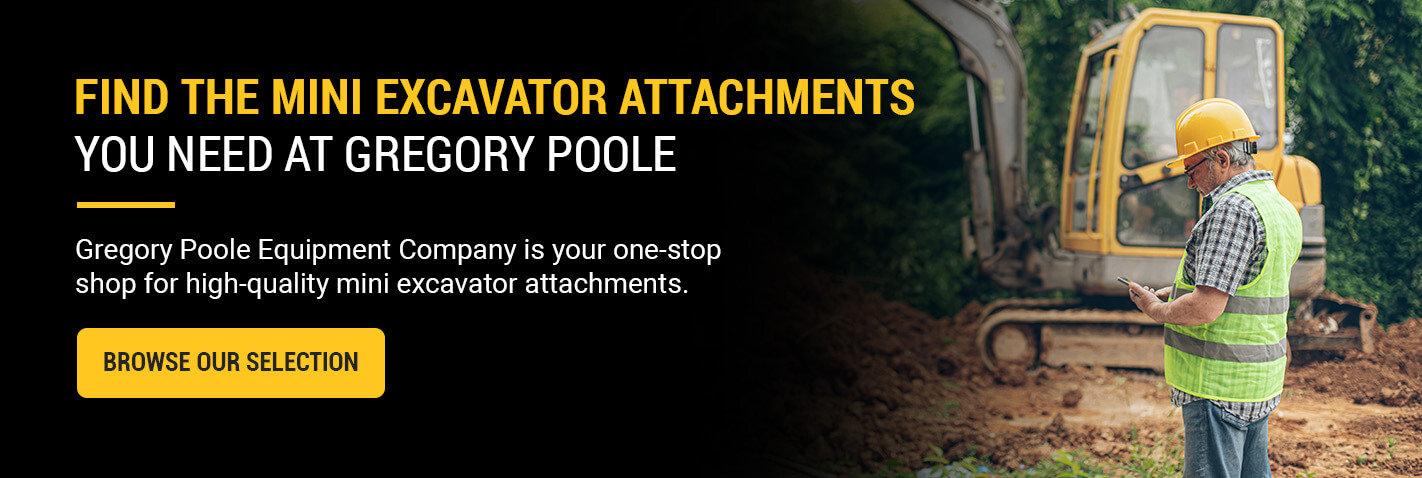
Mini excavators are perfect for digging holes and trenches in compact, hard-to-reach areas. Equipping your machine with the proper attachment can make the job even easier! Below, we’ll look at some must-have mini excavator attachments that can handle even the most demanding digging tasks.
Here are 10 common attachments for mini excavators that can make your projects quicker and simpler.
A hydraulic thumb is a large claw-like attachment that connects to a bucket. It makes it easier for the operator to lift, hold and transport oddly shaped materials that struggle to fit into a bucket, like:
This attachment is incredibly simple to maneuver, as you can use a joystick to adjust the speed. The shut-off valve lets you fold the thumb back when not in use. You can quickly reactivate the attachment as needed. Hydraulic thumbs also provide extra grip, so you can control how hard you clasp the material without crushing it.
This attachment is incredibly efficient and versatile. You can use it for several tasks, including:
An auger is an attachment designed for drilling holes into the ground. It can accommodate many terrains, including wood, pavement, soil and ice.
Performing these tasks with manual tools takes time and effort. An auger drill attachment simplifies and speeds up the process immensely. You can complete a variety of drilling applications, such as:
A coupler lets you switch between tools seamlessly without the need for a crew. For instance, if you need to replace a drill with a bucket, a coupler can help you swap out the parts quickly.
You also don’t have to leave the cab while operating this attachment. As you can imagine, it can make your projects faster and more productive. Couplers are a staple for construction projects that change tasks multiple times.
A hammer attachment helps break up and demolish materials. You can choose from different styles, depending on the material you’re dealing with. Here are a couple of examples:
A hammer attachment can yield reliable performance for roadwork, demolition and other construction projects. Whether breaking up concrete slabs, brickwork, driveways or pavement, it offers a versatile and efficient solution.

A grapple attachment has two large rotating clamps with teeth. This design lets it grab, lift and move heavy and awkwardly shaped materials, like:
Grapples are excellent for numerous construction and forestry tasks, like demolition, land-clearing and debris removal.
A bucket is arguably the most common excavator attachment. It scoops and moves large material volumes, like rocks, mulch, gravel and soil. It’s typically made from hard-grade steel to ensure maximum durability.
Bucket attachments come in many shapes, sizes and configurations that suit various digging tasks. Some different types include:
A mulcher attachment lets you cut and mulch excess vegetation, such as trees, logs, shrubs and weeds. You can then dispose of the chipped wood or recycle it for — you guessed it — mulch. These tools are convenient for clearing brush and trees along tough-to-reach areas, like:
A rake attachment contains fingers — or tines — with consistent sizes and even spaces. These tines allow for smooth soil preparation. They reduce and remove underlying roots, letting loose soil flow through.
This attachment breaks up large materials and clears excess debris from the worksite. It yields a clean surface for your construction project. You can also eliminate a variety of materials, including roots, brush, rocks and trash.
A ripper mounts to an excavator’s rear and breaks up ice, asphalt and other densely packed materials. It can also loosen and remove roots, rocks and pavement. It has a pointed end resembling a large tooth.
This construction lets it cut through various terrains with impeccable power and efficiency. It also produces minimal sound, letting you break ground without substantial noise concerns.
Buckets and other attachments often crack when digging into cold, hard ground. You’ll require a more specialized tool for this task. A ripper can create that initial tear in the ground when you need to puncture tough or frozen terrain. Whether landscaping, demolition or debris removal, a ripper attachment can streamline your project significantly.
A trencher is an attachment for digging excavations with a flat base and smooth walls. You can create trenches for installing and accessing the following items underground:
Trenchers can tackle a range of soil conditions, even the densest and rockiest types. Compared to buckets and other excavation attachments, they’re more ideal for tasks that require precise digging. Unlike some other tools, their narrow design lets them safely work near buildings and other objects. A trencher also yields more refined backfill, letting it return to the trench without sinkage.
Gregory Poole Equipment Company is your one-stop shop for high-quality mini excavator attachments. We have an array of Cat® equipment and tools available for rent and purchase. We’re proud to offer durable and reliable solutions from one of the biggest names in the heavy equipment industry.
Not exactly sure what you’re looking for? Our knowledgeable technicians can help you determine the right tools for your project. We also provide ongoing support after your purchase, so you can always reach out if you run into any questions or roadblocks.
Whether you’re in the market for a coupler, auger, mulcher or other attachment, Gregory Poole has your back. Browse our selection of tools and attachments and find the solutions you’re looking for today!
